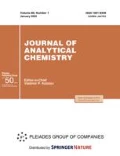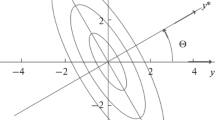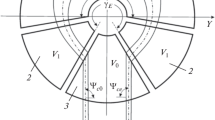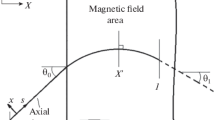Abstract
The axial aberration of the ion-optical system of a static mass analyzer is one of the main factors limiting the transmission and sensitivity of the instrument. We described an algorithm for selecting the optimal collimating system for a mass analyzer, which makes it possible to decrease this aberration effectively, with minimal loss in the intensity of the mass spectral lines. The algorithm is based on the representation of the considered aberration in the phase space as an ellipse and the optimal approximation of this aberration ellipse by a polygon with a given number of vertices. In the absence of constraints, the solution of the corresponding optimization problems is in phase polygons generated by regular polygons inscribed in a unit circle or circumscribed around a unit circle with the same number of vertices. After that, the unit circle along with the polygons is “stretched” to the size of the specified aberration ellipse along its main axes. Additional freedom of the rotation of the original polygon around the center of the unit circle can be used to position auxiliary slits of the collimating system more conveniently.



Similar content being viewed by others
REFERENCES
Sachenko, V.D., Antonov, A.S., Gall, L.N., et al., Mass-Spektrom., 2019, vol. 16, no. 2, p. 110.
Antonov, A.S., Berdnikov, A.S., Gall, L.N., et al., J. Anal. Chem., 2019, vol. 74, no. 14, p. 1405.
Wollnik, H., Optics of Charge Particles, New York: Academic, 1987.
Blaschke, W., Kreis und Kugel (Circle and Sphere), Berlin: de Gruyter, 1956.
Prasolov, V.V., Zadachi po planimetii (Problems on Planimetry), Moscow: Mosk. Tsentr Nepreryvn. Mat. Obraz., 2006. http://ilib.mccme.ru/pdf/planim5.htm.
Khursheed, A., Dinnis, A.R., and Smart, P.D., Microelectron. Eng., 1991, vol. 14, nos. 3–4, p. 197.
Khursheed, A., Microelectron. Eng., 1992, vol. 16, nos. 1–4, p. 43.
Khursheed, A., Phang, J.C., and Thong, J.T.L., Scanning, 1998, vol. 20, no. 2, p. 87.
Khursheed, A., Rev. Sci. Instrum., 2000, vol. 71, no. 4, p. 1712.
Khursheed, A., Optik (Munich, Ger.), 2002, vol. 113, no. 11, p. 505
Khursheed, A., Ultramicroscopy, 2002, vol. 93, nos. 3–4, p. 331.
Khursheed, A., Karuppiah, N., Osterberg, M., et al., Rev. Sci. Instrum., 2003, vol. 74, p. 134.
Khursheed, A. and Osterberg, M., Scanning, 2004, vol. 26, no. 6, p. 296.
Osterberg, M. and Khursheed, A., Nucl. Instrum. Methods Phys. Res., Sect. A, 2005, vol. 555, nos. 1–2, p. 20.
Khursheed, A. and Osterberg, M., Nucl. Instrum. Methods Phys. Res., Sect. A, 2006, vol. 556, no. 2, p. 437.
Luo, T. and Khursheed, A., J. Vac. Sci. Technol., B: Nanotechnol. Microelectron.: Mater., Process., Meas., Phenom., 2007, vol. 25, no. 6, p. 2017.
Khursheed, A. and Hoang, H.Q., Ultramicroscopy, 2008, vol. 109, no. 1, p. 104.
Khursheed, A., Scanning Electron Microscope Optics and Spectrometers, Singapore: World Scientific, 2010.
Hoang, H.Q. and Khursheed, A., Nucl. Instrum. Methods Phys. Res., Sect. A, 2011, vol. 635, no. 1, p. 64.
Hoang, H.Q., Osterberg, M., and Khursheed, A., Ultramicroscopy, 2011, vol. 111, no. 8, p. 1093.
Khursheed, A., Hoang, H.Q., and Srinivasan, A., J. Electron Spectrosc. Relat. Phenom., 2012, vol. 184, nos. 11–12, p. 525.
Shao, X., Srinivasan, A., Ang, W.K., and Khursheed, A., Nat. Commun., 2018, vol. 9, no. 1, p. 1288.
Wolfram Mathematica: The System for Modern Technical Computing. http://wolfram.com/mathematica.
Paint.NET: Free Software for Digital Photo Editing. http:// www.getpaint.net.
Wells, H.G., The Time Machine, London: William Heinemann, 1895.
ACKNOWLEDGMENTS
The authors are grateful to the reviewers for the comments that were taken into account in revising the article and to Yu.I. Denisova for editorial comments that made it possible to eliminate typos and stylistic errors. The figures were created using the Wolfram Mathematica version 11.0 [23] with subsequent manual editing in the Paint.NET graphic editor, version 4.1.5 [24]. The authors are grateful to Dr. D.E. Rosenthal for providing technical support while writing this article and highly esteemed S.B. Yahweh for helpful discussions on this topic.
Funding
This work was partially supported within the framework of research work 0074-2019-0009, which is part of the State order no. 075-00780-19-02 of the Ministry of Science and Higher Education of the Russian Federation for the Institute for Analytical Instrumentation, Russian Academy of Sciences.
Author information
Authors and Affiliations
Corresponding author
Ethics declarations
COMPLIANCE WITH ETHICAL STANDARDS
This article does not contain any research using animals as research objects. This article does not contain any research involving human subjects. This article does not contain any research using plants, and/or microorganisms, and/or fungi, and/or viruses, and/or intelligent minerals, and/or animated electromagnetic, gravitational or other types of fields, and/or artificial intelligence, and/or aliens as research objects. All applicable international, national, and/or institutional guidelines for the care and use of consultants, reviewers, editors, proofreaders, layout designers, translators, and typographers have been followed. This article does not contain criticism of the theory of global warming, as well as national, racial, gender, religious, ideological, psychological, mental, linguistic, egregorial, specific, or other types of intolerance, as well as provisions that contradict the provisions of the Commission of the Russian Academy of Sciences for Combating Pseudoscience and the Commission of the Russian Academy of Sciences for Counteracting the Falsification of Scientific Research, as well as denial of the Holocaust. The letters, numbers, punctuation marks, mathematical symbols, and spaces used in the article comply with the Unicode 12.0.0 standard dated March 5, 2019 and are used by the authors under the LaTeX Project Public License version 1.3, GNU General Public License version 3, and SIL Open Font License version 1.1 following the General Planetary International Linguistic Charter [25]. In proving the statements made in the article, the authors consistently adhered to Euclid’s axioms, and none of the axioms suffered.
CONFLICT OF INTERESTS
The authors declare no conflicts of interest, including financial ones.
Additional information
Translated by O. Zhukova
APPENDIX
APPENDIX
Statement 1. Of all N-gons inscribed in the unit circle, a regular N-gon has the largest area.
Evidence. An N-gon inscribed in a unit circle, up to rotation around the center of the circle, is uniquely characterized by a set of central angles φ1, φ2, …, φN formed by radii connecting the center of the circle and the vertices of the N-gon (Fig. 4a). If not all angles φ1, φ2, …, φN are the same, then there are two adjacent angles, one of which is larger than the other. Let, for example, φ1 < φ2. If we change these two angles according to the rule φ2 = φ2 – δ, \({{\hat {\varphi }}_{1}}\) = φ1 + δ, where δ = (φ2 – φ1)/2 > 0, leaving the remaining angles unchanged, then the condition \({{\hat {\varphi }}_{1}}\) = \({{\hat {\varphi }}_{2}}\) = (φ1 + φ2)/2 is fulfilled, and the area of the inscribed N-gon increases (Figs. 4b and 4c). Indeed, the sum of the areas of triangles A1OA2 and A2OA3 is
where R is the radius, Φ = (φ1 + φ2)/2, and φ = (φ2 – φ1)/2 and reaches a maximum at φ = 0. Therefore, an N-gon that differs from a regular N-gon, in which all central angles are the same, is not optimal.
Statement 2. Of all N-gons circumscribed around the unit circle, a regular N-gon has the smallest area.
Evidence. An N-gon circumscribed around the unit circle, up to rotation around the center, is uniquely characterized by a set of central angles φ1, φ2, …, φN formed by the radii connecting the center of the circle and the points of tangency of the sides of the N-gon with the circle, since as each tangent line and the points of intersection of the tangents (the vertices of the N-gon) are uniquely restored from the points of tangency (Fig. 5a). If not all angles φ1, φ2, …, φN are the same, then there are two adjacent angles, one of which is larger than the other. Let, for example, φ1 < φ2. If we change these two angles according to the rule \({{\hat {\varphi }}_{2}} = {{\varphi }_{2}}\) – δ, \({{\hat {\varphi }}_{1}} = {{\varphi }_{1}}\) + δ, where δ = (φ2 – φ1)/2 > 0, leaving the remaining angles unchanged, then the condition \({{\hat {\varphi }}_{1}} = {{\hat {\varphi }}_{2}}\) = (φ1 + φ2)/2 is fulfilled, and the area of the circumscribed N-gon decreases (Figs. 5b and 5c). Indeed, the sum of the areas of triangles B1OA1, B1OA2, B2OA2, and B2OA3 is
where R is the radius, Φ = (φ1 + φ2)/2, and φ = (φ2 – φ1)/2 and reaches a minimum at φ = 0. Therefore, an N-gon that differs from a regular N-gon, in which all central angles are the same, is not optimal.
Statement 3. Of all N-gons circumscribed around the unit circle, a regular N-gon has the least maximum distance from the center of the circle to its vertices.
Evidence. An N-gon circumscribed around a unit circle, up to rotation around the center of the circle, is uniquely characterized by a set of central angles φ1, φ2, …, φN formed by radii connecting the center of the circle and the points of tangency of the sides of the N-gon with the circle (Fig. 5a). The maximum distance from the center of the circle to the vertex of the N-gon is achieved for the maximum central angle φk and is R/cos(φk/2). If not all angles φ1, φ2, …, φN are the same, then there are two adjacent angles, one of which has the maximum value, and the neighboring one is smaller. For example, let these be the angles φ1 and φ2, with φ1 < φ2. If we change these two angles according to the rule \({{\hat {\varphi }}_{2}} = {{\varphi }_{2}}\) – δ, \({{\hat {\varphi }}_{1}} = {{\varphi }_{1}}\) + δ, where δ = (φ2 – φ1)/2 >0, leaving the remaining angles unchanged, then the condition \({{\hat {\varphi }}_{1}}\) = \({{\hat {\varphi }}_{2}}\) = (φ1 + φ2)/2 is fulfilled. Then the distance OB2 decreases, and the adjacent distance OB1 does not increase so much as to exceed the new value for OB2 (Figs. 5b and 5c). Repeating this operation for all central angles that have the maximum value at the moment, we get an N-gon with a smaller maximum distance from the center to the vertices. Therefore, an N-gon that differs from a regular N-gon, in which all central angles are the same, is not optimal.
Note. To avoid an infinite chain of iterations, it is necessary to select adjacent angles φ1 and φ2 at each step so that the larger of them is greater than 2π/N, and the smaller of them is less than 2π/N (which is always achievable, since in the sequence φ1, φ2, …, φN, the angles can be swapped to produce equivalent N-gons with the same values for any of the considered criteria). New angles \({{\hat {\varphi }}_{2}} = {{\varphi }_{2}}\) – δ, \({{\hat {\varphi }}_{1}} = {{\varphi }_{1}}\) + δ, where δ > 0, must be chosen so that at least one of them becomes 2π/N. As a result, for a finite number of steps, a regular N-gon is obtained (the only one suitable up to rotation around the center), while the criterion being optimized is invariably improved at each step. Now the statement is obvious that the only regular N-gon up to rotation ensures the largest (smallest) value for the criterion under consideration, and that the optimum is attainable rather is a limiting point, to which one can approach arbitrarily close but never reach it. The use of trigonometric expressions in the above calculations was needed only for a more concise presentation of the data, since the same results can be obtained from purely geometric considerations, and more elegantly.
Rights and permissions
About this article
Cite this article
Sachenko, V.D., Antonov, A.S., Gall, L.N. et al. Geometric Aspects of Optimizing the Acceptance of a Static Mass Analyzer. J Anal Chem 75, 1781–1789 (2020). https://doi.org/10.1134/S1061934820140129
Received:
Revised:
Published:
Issue Date:
DOI: https://doi.org/10.1134/S1061934820140129






